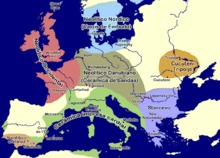Starčevo–Kőrös–Criș culture
 | |
| Period | Neolithic Europe |
|---|---|
| Dates | circa 5,800 B.C.E. — circa 4,500 B.C.E. |
| Type site | Starčevo |
| Preceded by | Mesolithic Romania, Neolithic Greece |
| Followed by | Gumelnița–Karanovo culture |
The Starčevo–Kőrös–Criş culture is a common name for a grouping of three related Neolithic archaeological cultures in Southeastern Europe: the Starčevo culture, the Kőrös culture, and the Criş culture.
- The Starčevo culture is an archaeological culture of Southeastern Europe, in what is now Serbia, dating to the Neolithic period between c. 5500 and 4500 BCE[1] (according to other source, between 6200 and 5200 BCE).[2] The Starčevo culture is sometimes grouped together and sometimes not.[3]
- The Kőrös culture is another Neolithic archaeological culture, but in Central Europe, that was named after the river Körös in eastern Hungary.[4]
- The Criş culture, in what is now Romania, survived from about 5800 to 5300 BC, and is the same culture as Kőrös. The different names for the two stem from different names for the same river. The river named Körös in Hungary becomes the Criş river in Romania.[4]
References
This article is issued from
Wikipedia.
The text is licensed under Creative Commons - Attribution - Sharealike.
Additional terms may apply for the media files.